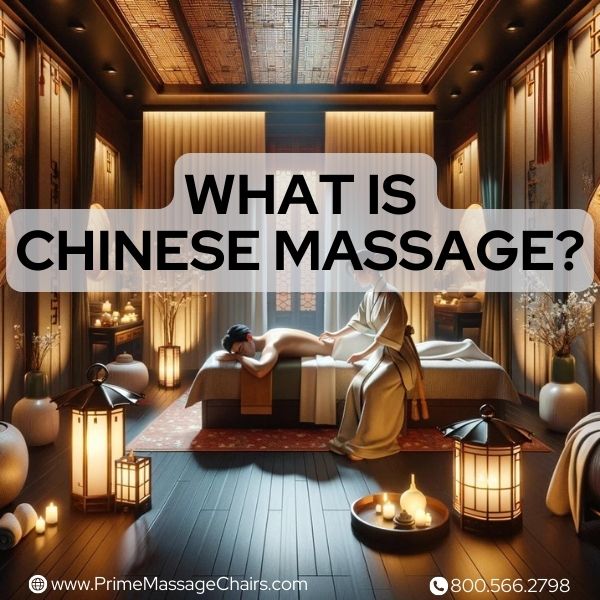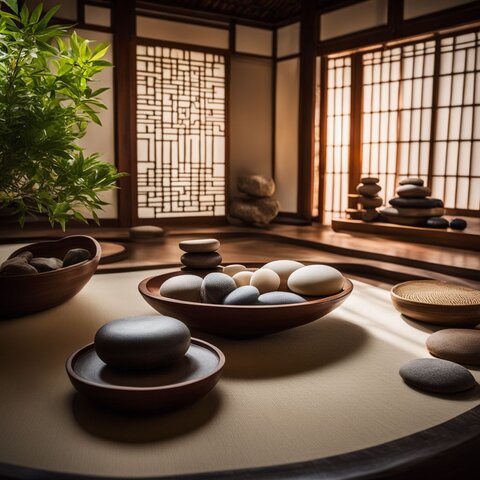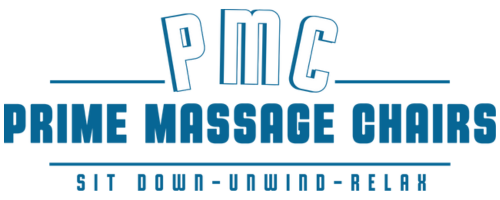
What is Chinese Massage?
What is Chinese massage and could it be right for you? Also known as Tui Na, Chinese massage is an ancient practice that has been soothing aches for centuries.
This article will guide you through its philosophies and show how it could be the key to relaxing your body and mind.
Now let's get started!
Understanding Chinese Massage
In exploring the essence of Chinese massage, we delve into a world where ancient wisdom and modern practice converge, offering an intricate system of healing that addresses both physical and energetic imbalances.

It is not merely a technique but also embodies a philosophy that interweaves traditional Chinese medicine principles with unique manipulative methods aimed at stimulating the body's capacity for self-healing, according to TCM theory.
The Philosophy behind Chinese Massage
Tui Na, a key component of Traditional Chinese Medicine, is based on the concept that vital energy, or 'Qi,' circulates throughout the body along channels or pathways known as 'meridians.
Traditional Chinese medicine identifies these paths and connects them to our health.
When Qi moves smoothly through the meridians, we feel good and stay healthy. Blockages or imbalances in this flow can lead to pain or sickness.
Massage therapists work with the meridian system during a Chinese massage session.
They aim to free up any blockages and help restore balance to your body's inner energy.
By pressing on certain acupressure points, they trigger changes inside your body.
While Tui Na is traditionally recognized for promoting relaxation and enhancing blood circulation, its impact on immunity and respiratory functions is still under investigation, with more research needed to draw definitive conclusions.
The goal is healing both physically and emotionally by realigning your Qi.
How Chinese Massage Works
Building on its philosophical roots, Chinese massage directly influences the body's energy and physical structure.
Practitioners use their palms, fingers, knuckles, elbows, and even feet to press on specific acupoints.
They follow the body's meridian system to release blocked qi.
This process is believed in TCM to spark changes that can relieve pain and improve health, though the specific biochemical mechanisms are not fully understood in the context of Western medicine.
With a focus on the soft tissue known as jin, therapists apply techniques like Tui na and Zhi ya.
They twist, pull, turn push and knead muscles to realign them. These methods promote blood flow and help with musculoskeletal problems.
Chinese massage aims to promote holistic health by focusing on the body's energy pathways, though the specific mechanisms and effects are still being explored by researchers.
It's essential to consult with a healthcare professional before beginning Tui Na or any new therapeutic practice to confirm it aligns with your specific health needs.
Techniques Used in Chinese Massage
Chinese massage, known as Tui Na, incorporates a diverse array of techniques that are intended to enhance the flow of Qi, or vital energy, throughout the body.

This practice skillfully combines various hand movements and manipulations to stimulate acupuncture points and energize muscles for holistic wellness.
Compression
Compression is a key technique in Chinese massage. The therapist presses on certain spots of your body.
They use their hands, fingers, or sometimes tools to push muscles and tissues.
This method can release tension and improve blood flow.
By pressing down firmly, therapists help sore areas start to relax.
Compression techniques target soft tissues to potentially ease tension, emphasizing the importance of technique and pressure application.
This helps with pain relief and works out knots in your body.
Friction
Friction plays a key role in traditional Chinese massage, also known as Tui na or Zhi ya.
Massage therapists use this technique to create heat and increase blood flow to tight areas.
They rub skin and muscles in the same direction or in circular motions. This helps break down scar tissue and eases soreness.
By applying friction, therapists aim to cause changes within the body that help re-balance Qi, which is the vital energy flow according to Traditional Chinese Medicine (TCM).
It's believed that restoring this balance promotes healing and reduces pain.
Whether it’s low back pain or muscular tension, friction techniques are believed to help with circulation and may support the recovery process, though individual results can vary.
Vibration
Vibration in Chinese massage can kick-start healing inside your body. Massage therapists use quick, shaking motions to wake up muscles and bones.
These vibrations can lead to important changes that help you heal.
They work deep in the tissue, helping to reduce swelling and pain after an injury.
This technique is a big part of why Chinese massage helps your body bounce back faster.
Vibrations might seem simple but they have a powerful effect on your well-being.
This kind of movement during a massage session targets areas needing extra care, especially if you're recovering from muscle harm or soreness.
Using vibration techniques are thought to contribute to the recovery process by potentially easing muscle tension, with the aim of supporting healing.
This technique is thought to help in the TCM context by potentially easing muscle tension and promoting recovery, though the mechanism and effectiveness may vary from person to person.
Pinching and Grasping
Pinching and grasping techniques are integral to Tui Na, aimed at promoting overall well-being.
These methods are traditionally believed to aid in alleviating lower back pain and revitalizing energy.
However, any claims about their benefits for heart health and high blood pressure are not yet supported by robust scientific evidence and should be approached with caution.
The pinching and grasping methods are designed to engage with the body's energy flow, aiming to enhance well-being.
The therapist will rhythmically pick up and squeeze your skin and muscles. This isn't just to make you feel good - it’s done to get the Qi moving properly through your chest.
This technique doesn’t only renew your energy.It is traditionally believed to help with lower back pain, and some practitioners claim it may contribute to heart health and lower high blood pressure, but more research is needed to substantiate these benefits.
When soft tissues are pinched and grasped in a certain way, it sets off changes inside your body that help with healing.
Joint Manipulation
Moving beyond pinching and grasping, joint manipulation in Chinese massage involves careful techniques to potentially improve joint mobility and comfort.
Therapists use this technique to target areas that feel stiff or locked. They may rotate, pull, or press on limbs carefully to encourage the joints to move freely again.
With joint manipulation, there's an emphasis on correcting misalignments within the body's musculoskeletal system.
While some patients with conditions like arthritis or frozen shoulder may experience an increased range of motion, it's important to approach these treatments under the guidance of healthcare professionals.
Regularly applying this method may help maintain healthy joints, reduce pain levels, and support overall physical health.
Potential Benefits of Chinese Massage
Discover the transformative effects of this ancient practice, where relief from physical pain and emotional stress meets enhanced overall well-being.

Engage with the healing power of Chinese massage that not only targets musculoskeletal issues but also promotes deeper physiological changes for a balanced and rejuvenated self.
Pain Relief
While some studies suggest potential benefits of Chinese massage for individuals with chronic pain or arthritis, it's important to note that research is ongoing, and evidence varies.
It targets the soft tissue, known as jin, to ease discomfort in areas like the back and neck.
This approach activates qi, or body energy, which helps reduce inflammation and encourages healing.
People often seek out this type of massage therapy for low-back pain, joint issues, and headaches.
There is evidence to suggest potential benefits in promoting joint flexibility for those with conditions like rheumatoid arthritis.
After a session of Chinese massage, some may feel soreness; this is typical as the body adjusts to physiological changes from the treatment.
To help recovery after a massage, drinking plenty of water is crucial.
Faster Injury Recovery
Moving from easing pain to enhancing healing, Chinese massage stands out for its ability to speed up recovery from injuries.
Tui na techniques target soft tissue, prompting the body to heal faster.
This form of bodywork stimulates circulation and helps with the realignment of muscles and bones. It's especially helpful after a sprain or fracture.
The manipulation involved in tui na encourages the body to release natural painkillers and growth factors that are vital for repair and regeneration.
People find relief after surgery too, as Chinese massage can reduce swelling and lead to quicker rehabilitation.
Practitioners use their hands to activate qi flow, which is believed to remove blockages that slow down the healing process.
By integrating movements like compression and joint manipulation, this massage technique fosters an environment where tissues mend more efficiently, getting you back on your feet sooner than expected.
Improved Balance
Chinese massage therapy helps you find your footing. It works on your muscles and joints to make them stronger.
Strong muscles support better balance and coordination. This is great for anyone at any age.
Massage techniques like tui-na push and pull your body into alignment.
Your body energy, or qi, flows better when everything's in the right place. That means you stand steadier and move with more grace.
After regular sessions, walking feels easier, even on rough ground.
Increased Circulation
Massaging helps your body move blood through areas that may be congested or tired.
Better circulation can lead to faster healing and reduced swelling from injuries.
Chinese massage techniques like compression and joint manipulation boost this even more.
They push against the deeper layers of muscle, helping to increase overall blood flow.
This improvement in circulation also means more oxygen gets to your body's cells.
Oxygen is vital for cell growth and repair, so more of it helps your muscles recover from stress and strain quickly.
FAQs
What does Chinese massage focus on?
Chinese massage focuses on realigning the musculoskeletal system, improving qi (body energy), and often includes using herbs and techniques like cupping.
How is Chinese massage different from Western massage?
Chinese massage involves deep tissue work, qi gong exercises, and may use Chinese herbal medicines for a holistic approach, unlike Western massages that mainly involve relaxation.
Can Chinese massage help with health issues?
Potentially, yes, it can help reduce stress, ease neck pain, improve emotional health, and treat symptoms of conditions like migraines and osteoarthritis.
What are some special methods used in Chinese massages?
Special methods include reflexology for your feet or hands, acupuncture to adjust body energy flow (qi), and qigong movements to support healing.
Is music therapy part of Chinese Massage?
Although ambient music is not a traditional aspect of Tui Na, it is sometimes used by practitioners to foster a tranquil setting that complements the relaxation process.
Do they only use hands in Chinese massage treatments?
While primarily utilizing hand techniques, Tui Na practitioners may also incorporate traditional tools such as cupping and gua sha to enhance therapeutic outcomes for certain conditions.
Conclusion
Chinese massage aims to support both physical and mental well-being, as part of a holistic approach to health.
While there is growing interest in the potential benefits of Tui Na for various health conditions, more research is needed to fully understand its effectiveness.
The understanding of Tui Na's effectiveness and mechanisms is continually evolving, with new research shedding light on its potential benefits and limitations.
Readers should consult healthcare professionals before using Tui Na as a treatment for specific health issues.
Disclaimer:
We do not provide medical advice. The content of this article, including text, graphics, and other material, is for informational purposes only. It is not intended to be a substitute for professional medical advice, diagnosis, or treatment. Always seek the advice of your physician or other qualified health provider with any questions you may have regarding a health condition. Never disregard professional medical advice or delay in seeking it because of something you have read in this article or on our website.
